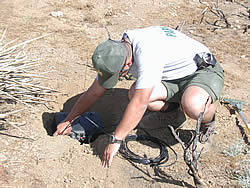
National Fire Plan Success Story
Law Enforcement Presence Critical for Protecting Resource Following Mojave Desert Wildland Fires
Mojave National Preserve, California
National Fire Plan - Community Assistance

National Park Service Law Enforcement Ranger Wayne Dingman installs a seismic ground sensor at Mojave National Preserve.
Sensitive resources such as cultural sites and wildlife and plant species are often vulnerable to illegal collection and other disturbances following wildland fires. The recently completed Interagency Burned Area Emergency Response (BAER) Guidebook allows the use of BAER funds to finance law enforcement patrols for resource protection purposes. However, the same document notes that patrols should be used only when alternative protection tactics, such as installing gates and signs or burying or camouflaging sensitive cultural sites, are infeasible. Recent experiences following wildland fires at National Park Service units in the Mojave Desert demonstrated the importance of law enforcement patrols for resource protection in that region.
During the 2005 and 2006 fire seasons, more than 85,000 acres burned in Death Valley National Park and Mojave National Preserve. Following the Hackberry Complex at Mojave National Preserve in 2005, park staff was amazed at the number of abandoned road and trail traces that were visible with the loss of vegetation. In addition to improved accessibility, vegetation loss also left critical natural resources exposed and vulnerable to impacts. Evidence of looting was noted at a significant archeological site within a few weeks of the fire. BAER Implementation Leader, Sandee Dingman, worked with law enforcement personnel at both parks to coordinate and document patrol activities within and around the burned areas. This included providing maps of sensitive resource locations, specialized burned area patrol logs, and installing and maintaining seismic ground sensors on roads. In addition, BAER funded use of the park aircraft at Death Valley National Park to more effectively patrol widely-spaced burned areas.
Are law enforcement patrols effective at preventing post-fire resource violations? Although visitor contacts were made and citations issued in the burned areas at both Mojave Preserve and Death Valley, patrol logs and other evidence, such web blogs frequented by habitual resource violators, suggested that activity within the burned areas was reduced by increased law enforcement presence. While slow recovery of vegetation means that sensitive resources remain vulnerable far longer than the one year post-fire period during which BAER funds are available, law enforcement patrols are critical for reducing post-fire resource violations in desert settings.
Contact: Nelson Siefkin, Pacific West Region BAER Coordinator, Phone: (510) 817-1502